Development Trends and Research Frontiers of Preferential Flow in Soil Based on CiteSpace
Abstract
1. Introduction
2. Materials and Methods
3. Results
3.1. Analysis of Literature Output Quantity
3.2. Co-Occurrence Analysis of Keywords
3.3. Cluster Analysis of Keywords
3.4. Analysis of Burst Terms
3.5. Distribution of Countries and Cooperative Relationship between Them
3.6. Knowledge Map Analysis of Research Institutions
4. Discussion
4.1. Research Trend of Preferential Flow
- (1)
- Increased understanding of influence of preferential flow
- (2)
- Development of experimental techniques
- (3)
- Development of computational methods
4.2. Fields Involved in Preferential Flow Research
4.3. Two Categories of Research on Preferential Flow
4.4. Analysis of Research Hotspots
4.4.1. New Experimental Testing Methods of Preferential Flow
- (1)
- Image interpretation is only used.
- (2)
- A great difference between sampling and measurement brings difficulty in comparison.
- (3)
- It is difficult to directly measure parameters at pore-scale.
4.4.2. Preferential Flow in Water-Repellent Soil
4.4.3. Influence of Preferential Flow on Slope Stability
4.5. Future Research Directions
4.6. Comparison with other Literature Analysis Methods
4.6.1. Comparison of Literature Selection
4.6.2. Comparison between Analysis Methods
4.6.3. Comparison between Analysis Results
5. Conclusions
- (1)
- Preferential flow is a multi-scale phenomenon in essence. The future research on preferential flow should focus on establishing appropriate computational models, linking the production mechanism of preferential flow at pore scale to macro phenomena, and explaining the causes of macro phenomena.
- (2)
- Researchers from different disciplines carry out the same research on preferential water flow and pollution at different scales. A clearer and more common understanding of preferential flow will be reached due to multi-disciplinary cross-integration in the future.
- (3)
- The current research trends indicate that researchers in different fields are paying more attention to preferential flow phenomena and will gradually increase their research efforts. International cooperation can better promote scientific research. The research hotspots are mainly concentrated in two dimensions: new experimental techniques and computational methods, and new ideas brought about by multi-disciplinary cross-integration. This provides future research directions for researchers in related fields.
- (4)
- Bibliometrics methods are based on statistical theory and used for quantitative analysis and statistics of literature data indicators, which are not available in other literature analysis methods. The bibliometrics methods involve a comprehensive range of disciplines when used for retrieving studies to analyze cross-disciplinary issues.
Author Contributions
Funding
Acknowledgments
Conflicts of Interest
References
- Yan, J.; Chen, X.; Cai, Y.; Cheng, F.; Fan, T. A review of genetic classification and characteristics of soil cracks. Open Geosci. 2021, 13, 1509–1522. [Google Scholar] [CrossRef]
- Nimmo, J.R. The processes of preferential flow in the unsaturated zone. Soil Sci. Soc. Am. J. 2021, 85, 1–27. [Google Scholar] [CrossRef]
- Jarvis, N.; Koestel, J.; Larsbo, M. Understanding preferential flow in the vadose zone: Recent advances and future prospects. Vadose Zone J. 2016, 15, 1–11. [Google Scholar] [CrossRef]
- Beven, K. A century of denial: Preferential and nonequilibrium water flow in soils, 1864–1984. Vadose Zone J. 2018, 17, 1–17. [Google Scholar] [CrossRef]
- Zhang, Y.; Zhang, Z.; Ma, Z.; Chen, J.; Akbar, J.; Zhang, S.; Che, C.; Zhang, M.; Cerdà, A. A review of preferential water flow in soil science. Can. J. Soil Sci. 2018, 98, 604–618. [Google Scholar] [CrossRef]
- Zhang, W.; Jiang, F.; Sun, W. Investigating colloid-associated transport of cadmium and lead in a clayey soil under preferential flow conditions. Water Sci. Technol. 2021, 84, 2486–2498. [Google Scholar] [CrossRef] [PubMed]
- Franklin, S.M.; Kravchenko, A.N.; Vargas, R.; Vasilas, B.; Fuhrmann, J.J.; Jin, Y. The unexplored role of preferential flow in soil carbon dynamics. Soil Biol. Biochem. 2021, 161, 108398. [Google Scholar] [CrossRef]
- Zhen, Q.; Ma, W.; Li, M.; He, H.; Zhang, X.; Wang, Y. Effects of vegetation and physicochemical properties on solute transport in reclaimed soil at an opencast coal mine site on the Loess Plateau, China. Catena 2015, 133, 403–411. [Google Scholar] [CrossRef]
- Zhang, Z.; Si, B.; Li, H.; Li, M. Quantify piston and preferential water flow in deep soil using Cl− and soil water profiles in deforested apple orchards on the Loess Plateau, China. Water 2019, 11, 2183. [Google Scholar] [CrossRef]
- King, K.W.; Williams, M.R.; Macrae, M.L.; Fausey, N.R.; Frankenberger, J.; Smith, D.R.; Kleinman, P.J.A.; Brown, L.C. Phosphorus transport in agricultural subsurface drainage: A review. J. Environ. Qual. 2015, 44, 467–485. [Google Scholar] [CrossRef]
- Ronchetti, F.; Piccinini, L.; Deiana, M.; Ciccarese, G.; Vincenzi, V.; Aguzzoli, A.; Malavasi, G.; Fabbri, P.; Corsini, A. Tracer test to assess flow and transport parameters of an earth slide: The Montecagno landslide case study (Italy). Eng. Geol. 2020, 275, 105749. [Google Scholar] [CrossRef]
- Zhang, J.; Luo, Y.; Zhou, Z.; Chong, L.; Victor, C.; Zhang, Y. Effects of preferential flow induced by desiccation cracks on slope stability. Eng. Geol. 2021, 288, 106164. [Google Scholar] [CrossRef]
- Li, M.; Yao, J.; Cheng, J. Study on the preferential flow characteristics under different precipitation amounts in Simian mountain grassland of China. Water 2020, 12, 3489. [Google Scholar] [CrossRef]
- Jiang, X.J.; Chen, C.; Zhu, X.; Zakari, S.; Singh, A.K.; Zhang, W.; Zeng, H.; Yuan, Z.; He, C.; Yu, S.; et al. Use of dye infiltration experiments and HYDRUS-3D to interpret preferential flow in soil in a rubber-based agroforestry systems in Xishuangbanna, China. Catena 2019, 178, 120–131. [Google Scholar] [CrossRef]
- Di Prima, S.; Marrosu, R.; Lassabatere, L.; Angulo-Jaramillo, R.; Pirastru, M. In situ characterization of preferential flow by combining plot- and point-scale infiltration experiments on a hillslope. J. Hydrol. 2018, 563, 633–642. [Google Scholar] [CrossRef]
- Krzeminska, D.M.; Bogaard, T.A.; Malet, J.P.; van Beek, L.P.H. A model of hydrological and mechanical feedbacks of preferential fissure flow in a slow-moving landslide. Hydrol. Earth Syst. Sci. 2013, 17, 947–959. [Google Scholar] [CrossRef]
- Shan, W.; Liu, C.; Yu, J. Features of the discipline knowledge network: Evidence from China. Technol. Econ. Dev. Econ. 2014, 20, 45–64. [Google Scholar] [CrossRef]
- Mokhnacheva, Y.V.; Tsvetkova, V.A. Bibliometric analysis of soil science as a scientific area. Eurasian Soil Sci. 2020, 53, 838–844. [Google Scholar] [CrossRef]
- Liu, Z.; Yin, Y.; Liu, W.; Dunford, M. Visualizing the intellectual structure and evolution of innovation systems research: A bibliometric analysis. Scientometrics 2015, 103, 135–158. [Google Scholar] [CrossRef]
- Koondhar, M.A.; Shahbaz, M.; Memon, K.A.; Ozturk, I.; Kong, R. A visualization review analysis of the last two decades for environmental Kuznets curve “EKC” based on co-citation analysis theory and pathfinder network scaling algorithms. Environ. Sci. Pollut. Res. 2021, 28, 16690–16706. [Google Scholar] [CrossRef]
- Wu, J.; Wu, X.; Zhang, J. Development trend and frontier of stormwater management (1980–2019): A bibliometric overview based on CiteSpace. Water 2019, 11, 1908. [Google Scholar] [CrossRef]
- Zhong, S.; Chen, R.; Song, F.; Xu, Y. Knowledge mapping of carbon footprint research in a LCA perspective: A visual analysis using CiteSpace. Processes 2019, 7, 818. [Google Scholar] [CrossRef]
- Sun, L.; Xu, X.; Yang, Y.; Liu, W.; Jin, J. Knowledge mapping of supply chain risk research based on CiteSpace. Comput. Intell. 2020, 36, 1686–1703. [Google Scholar] [CrossRef]
- Gao, C.; Wang, R.; Zhang, L.; Yue, C. Visualization analysis of CRISPR gene-editing knowledge map based on CiteSpace. Biol. Bull. 2021, 48, 705–720. [Google Scholar] [CrossRef]
- Clothier, B.E.; Green, S.R.; Deurer, M. Preferential flow and transport in soil: Progress and prognosis. Eur. J. Soil Sci. 2008, 59, 2–13. [Google Scholar] [CrossRef]
- Pluer, W.T.; Macrae, M.; Buckley, A.; Reid, K. Contribution of preferential flow to tile drainage varies spatially and temporally. Vadose Zone J. 2020, 19, 1–15. [Google Scholar] [CrossRef]
- Gassmann, M. Modelling the fate of pesticide transformation products from plot to catchment scale—state of knowledge and future challenges. Front. Environ. Sci. 2021, 9, 717738. [Google Scholar] [CrossRef]
- Willkommen, S.; Lange, J.; Ulrich, U.; Pfannerstill, M.; Fohrer, N. Field insights into leaching and transformation of pesticides and fluorescent tracers in agricultural soil. Sci. Total Environ. 2021, 751, 141658. [Google Scholar] [CrossRef]
- Kukemilks, K.; Wagner, J.F.; Saks, T.; Brunner, P. Conceptualization of preferential flow for hillslope stability assessment. Hydrogeol. J. 2018, 26, 439–450. [Google Scholar] [CrossRef]
- González-Arteaga, J.; Moya, M.; Yustres, Á.; Alonso, J.; Merlo, O.; Navarro, V. Characterisation of the water content distribution beneath building foundations. Measurement 2019, 136, 82–92. [Google Scholar] [CrossRef]
- Que, Y.; Lin, P.; Lin, D. Integrative analysis of surface runoff and macropore flow for slopes under rainfall conditions. Math. Probl. Eng. 2018, 2018, 9458410. [Google Scholar] [CrossRef]
- Zhu, L.; Fan, D.; Ma, R.; Zhang, Y.; Zha, Y. Experimental and numerical investigations of influence on overland flow and water infiltration by fracture networks in soil. Geofluids 2018, 2018, 7056858. [Google Scholar] [CrossRef]
- Laurenson, S.; Cichota, R.; Reese, P.; Breneger, S. Irrigation runoff from a rolling landscape with slowly permeable subsoils in New Zealand. Irrig. Sci. 2018, 36, 121–131. [Google Scholar] [CrossRef]
- Glaser, B.; Jackisch, C.; Hopp, L.; Klaus, J. How meaningful are plot-scale observations and simulations of preferential flow for catchment models? Vadose Zone J. 2019, 18, 1–18. [Google Scholar] [CrossRef]
- Dusek, J.; Vogel, T. Modeling travel time distributions of preferential subsurface runoff, deep percolation and transpiration at a montane forest hillslope site. Water 2019, 11, 2396. [Google Scholar] [CrossRef]
- Karan, S.; Badawi, N.; Jensen, A.M.D.; Rosenbom, A.n.E. Impact of fate properties, groundwater fluctuations and the presence of worm burrows on pesticide leaching assessments through golf areas. Environ. Pollut. 2021, 289, 117822. [Google Scholar] [CrossRef]
- Li, M.; Yao, J.; Yan, R.; Cheng, J. Effects of infiltration amounts on preferential flow characteristics and solute transport in the protection forest soil of southwestern China. Water 2021, 13, 1301. [Google Scholar] [CrossRef]
- Rahbeh, M.; Srinivasan, R.; Mohtar, R. Numerical and conceptual evaluation of preferential flow in Zarqa River Basin, Jordan. Ecohydrol. Hydrobiol. 2019, 19, 224–237. [Google Scholar] [CrossRef]
- Aguilar-López, J.P.; Bogaard, T.; Gerke, H.H. Dual-permeability model improvements for representation of preferential flow in fractured clays. Water Resour. Res. 2020, 56, e2020WR027304. [Google Scholar] [CrossRef]
- Lassabatere, L.; Di Prima, S.; Bouarafa, S.; Iovino, M.; Bagarello, V.; Angulo-Jaramillo, R. BEST-2K method for characterizing dual-permeability unsaturated soils with ponded and tension infiltrometers. Vadose Zone J. 2019, 18, 1–20. [Google Scholar] [CrossRef]
- Fox, G.A.; Heeren, D.M.; Miller, R.B.; Mittelstet, A.R.; Storm, D.E. Flow and transport experiments for a streambank seep originating from a preferential flow pathway. J. Hydrol. 2011, 403, 360–366. [Google Scholar] [CrossRef]
- Di Pietro, L.; Ruy, S.; Capowiez, Y. Predicting preferential water flow in soils by traveling-dispersive waves. J. Hydrol. 2003, 278, 64–75. [Google Scholar] [CrossRef]
- Lissy, A.S.; Sammartino, S.; Ruy, S. Can structure data obtained from CT images substitute for parameters of a preferential flow model? Geoderma 2020, 380, 114643. [Google Scholar] [CrossRef]
- Li, Z.; Hu, X.; Li, X.; Huang, Y.; Wu, X.; Wang, P.; Liu, L. Quantification of soil macropores at different slope positions under alpine meadow using computed tomography in the Qinghai Lake watershed, NE Qinghai–Tibet. Eurasian Soil Sci. 2019, 52, 1391–1401. [Google Scholar] [CrossRef]
- Sammartino, S.; Lissy, A.S.; Bogner, C.; Van Den Bogaert, R.; Capowiez, Y.; Ruy, S.; Cornu, S. Identifying the functional macropore network related to preferential flow in structured soils. Vadose Zone J. 2015, 14, 1–16. [Google Scholar] [CrossRef]
- Zhang, Q.; Dong, Y.; Deng, H.; Elsworth, D. High-resolution characterization of nanoparticle transport in heterogeneous porous media via low-field nuclear magnetic resonance. J. Hydrol. 2020, 583, 124558. [Google Scholar] [CrossRef]
- Liu, M.; Guo, L.; Yi, J.; Lin, H.; Lou, S.; Zhang, H.; Li, T. Characterising preferential flow and its interaction with the soil matrix using dye tracing in the Three Gorges Reservoir Area of China. Soil Res. 2018, 56, 588–600. [Google Scholar] [CrossRef]
- Fuentes, I.; Casanova, M.; Seguel, O.; Padarian, J.; Nájera, F.; Salazar, O. Preferential flow paths in two alluvial soils with long-term additions of pig slurry in the Mediterranean zone of Chile. Soil Res. 2015, 53, 433–447. [Google Scholar] [CrossRef]
- Haas, C.; Horn, R.; Ellerbrock, R.H.; Gerke, H.H. Fluorescence imaging for mm-scale observation of macropore-matrix mass transfer: Calibration experiments. Geoderma 2020, 360, 114002. [Google Scholar] [CrossRef]
- Luo, Z.; Niu, J.; Xie, B.; Zhang, L.; Chen, X.; Berndtsson, R.; Du, J.; Ao, J.; Yang, L.; Zhu, S. Influence of root distribution on preferential flow in deciduous and coniferous forest soils. Forests 2019, 10, 986. [Google Scholar] [CrossRef]
- Jiang, B.; Cui, B.; Wang, Y.; Wang, Y.; Li, D.; Wang, L.; Li, X. Stable-isotope tracing of vadose-zone water transport in Achnatherum splendens grassland of the Qinghai Lake Basin, NE Qinghai–Tibet Plateau, China. Catena 2021, 200, 105088. [Google Scholar] [CrossRef]
- Mueller, M.H.; Alaoui, A.; Kuells, C.; Leistert, H.; Meusburger, K.; Stumpp, C.; Weiler, M.; Alewell, C. Tracking water pathways in steep hillslopes by δ18O depth profiles of soil water. J. Hydrol. 2014, 519, 340–352. [Google Scholar] [CrossRef]
- Robert, T.; Caterina, D.; Deceuster, J.; Kaufmann, O.; Nguyen, F. A salt tracer test monitored with surface ERT to detect preferential flow and transport paths in fractured/karstified limestones. Geophysics 2012, 77, B55–B67. [Google Scholar] [CrossRef]
- Smettem, K.R.J.; Rye, C.; Henry, D.J.; Sochacki, S.J.; Harper, R.J. Soil water repellency and the five spheres of influence: A review of mechanisms, measurement and ecological implications. Sci. Total Environ. 2021, 787, 147429. [Google Scholar] [CrossRef]
- Mao, J.; Nierop, K.G.J.; Dekker, S.C.; Dekker, L.W.; Chen, B. Understanding the mechanisms of soil water repellency from nanoscale to ecosystem scale: A review. J. Soils Sediments 2019, 19, 171–185. [Google Scholar] [CrossRef]
- DeBano, L.F. Water repellency in soils: A historical overview. J. Hydrol. 2000, 231–232, 4–32. [Google Scholar] [CrossRef]
- Wang, Y.; Wang, X.; Chau, H.W.; Si, B.; Yao, N.; Li, Y. Water movement and finger flow characterization in homogeneous water-repellent soils. Vadose Zone J. 2018, 17, 1–12. [Google Scholar] [CrossRef]
- Mirbabaei, S.M.; Shabanpour, M.; van Dam, J.; Ritsema, C.; Zolfaghari, A.; Khaledian, M. Observation and simulation of water movement and runoff in a coarse texture water repellent soil. Catena 2021, 207, 105637. [Google Scholar] [CrossRef]
- Cueto-Felgueroso, L.; Suarez-Navarro, M.J.; Fu, X.; Juanes, R. Numerical simulation of unstable preferential flow during water infiltration into heterogeneous dry soil. Water 2020, 12, 909. [Google Scholar] [CrossRef]
- Shao, W.; Yang, Z.; Ni, J.; Su, Y.; Nie, W.; Ma, X. Comparison of single- and dual-permeability models in simulating the unsaturated hydro-mechanical behavior in a rainfall-triggered landslide. Landslides 2018, 15, 2449–2464. [Google Scholar] [CrossRef]
- Shao, W.; Bogaard, T.A.; Bakker, M.; Greco, R. Quantification of the influence of preferential flow on slope stability using a numerical modelling approach. Hydrol. Earth Syst. Sci. 2015, 19, 2197–2212. [Google Scholar] [CrossRef]
- Valis, D.; Hasilová, K.; Forbelská, M.; Pietrucha-Urbanik, K. Modelling water distribution network failures and deterioration. Proceedings of 2017 IEEE International Conference on Industrial Engineering and Engineering Management (IEEM), Singapore, 10–13 December 2017; pp. 924–928. [Google Scholar] [CrossRef]
- Luo, Y.; Zhang, J.; Zhou, Z.; Shen, Z.; Chong, L.; Victor, C. Investigation and prediction of water infiltration process in cracked soils based on a full-scale model test. Geoderma 2021, 400, 115111. [Google Scholar] [CrossRef]
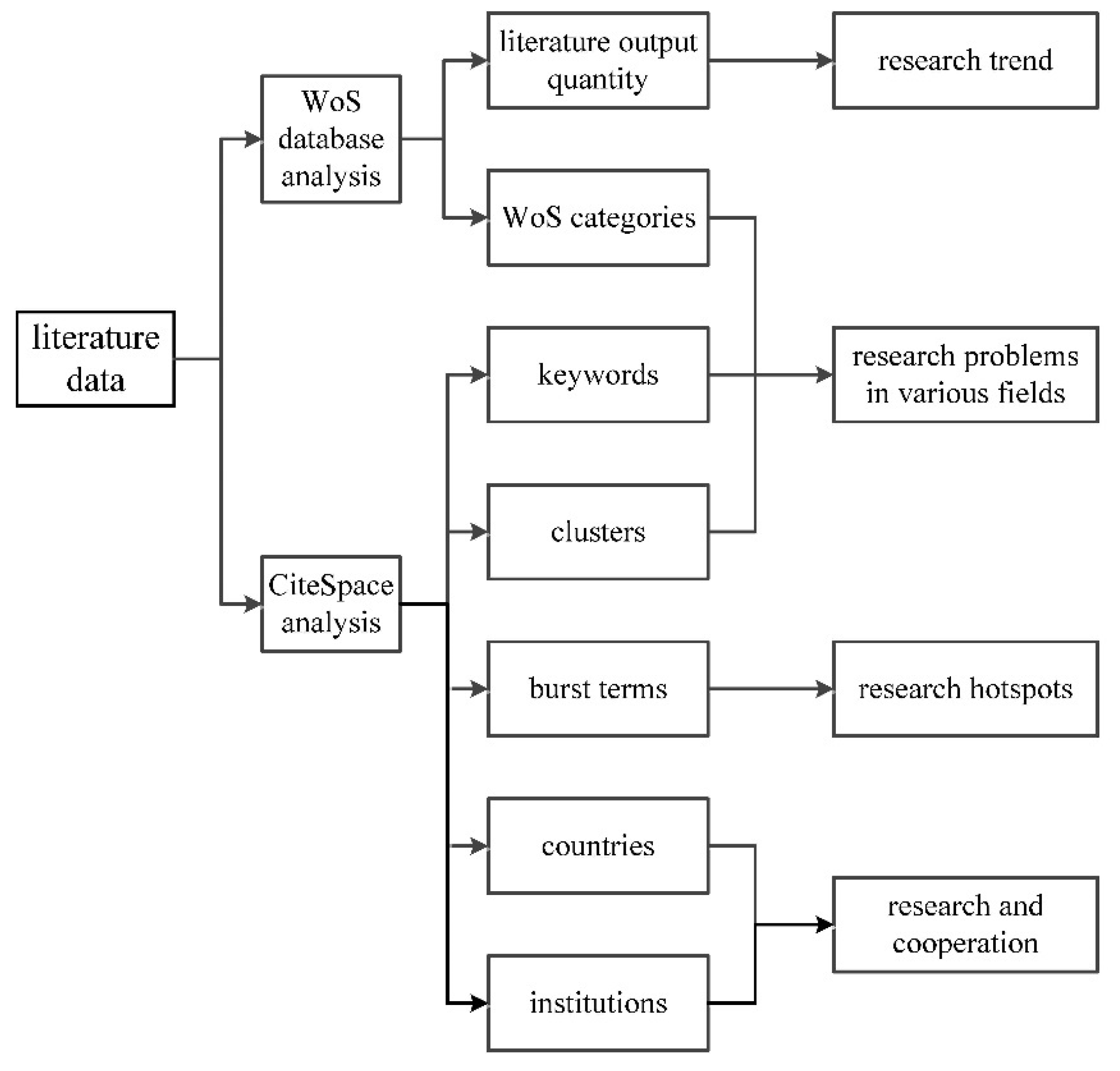
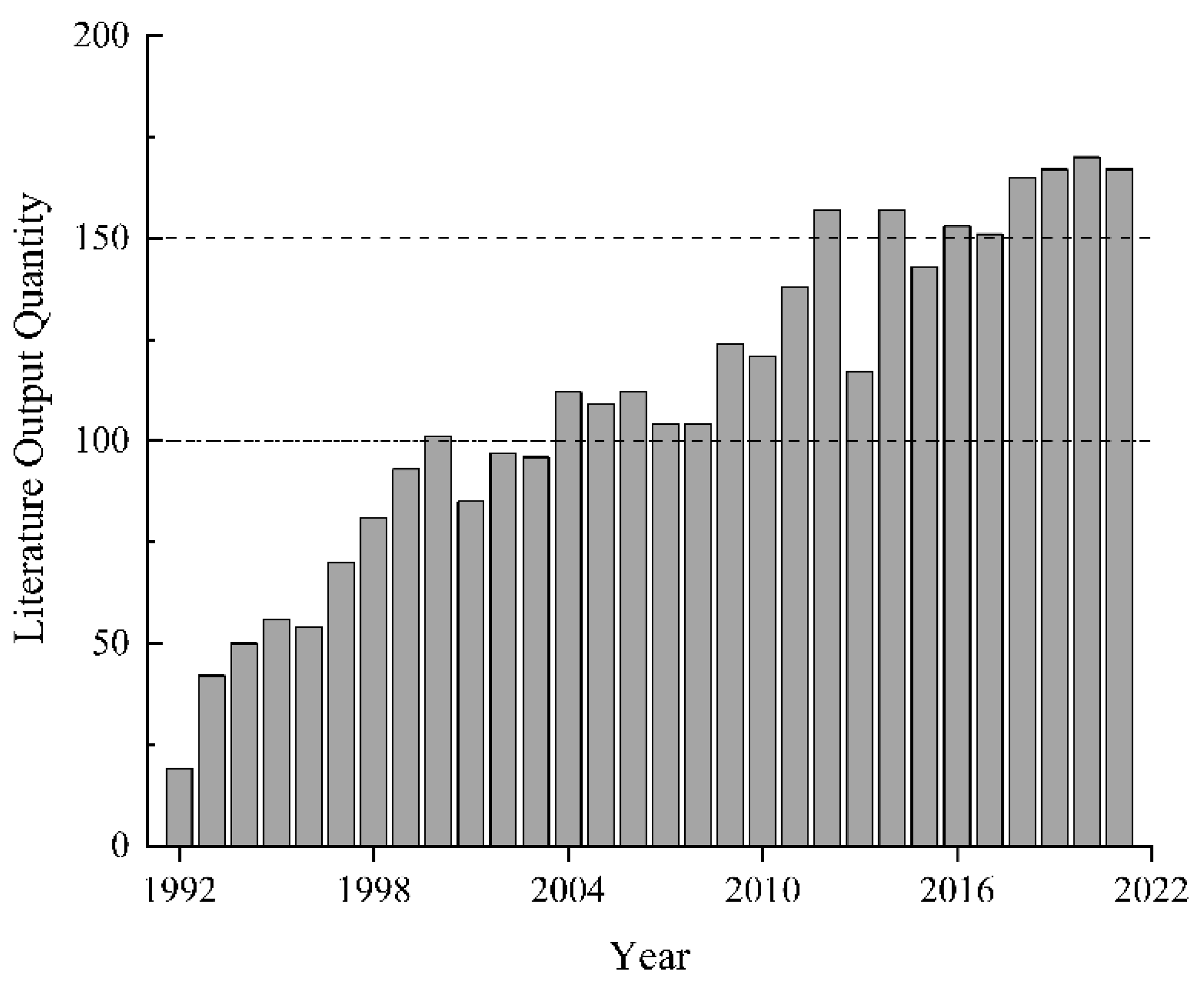

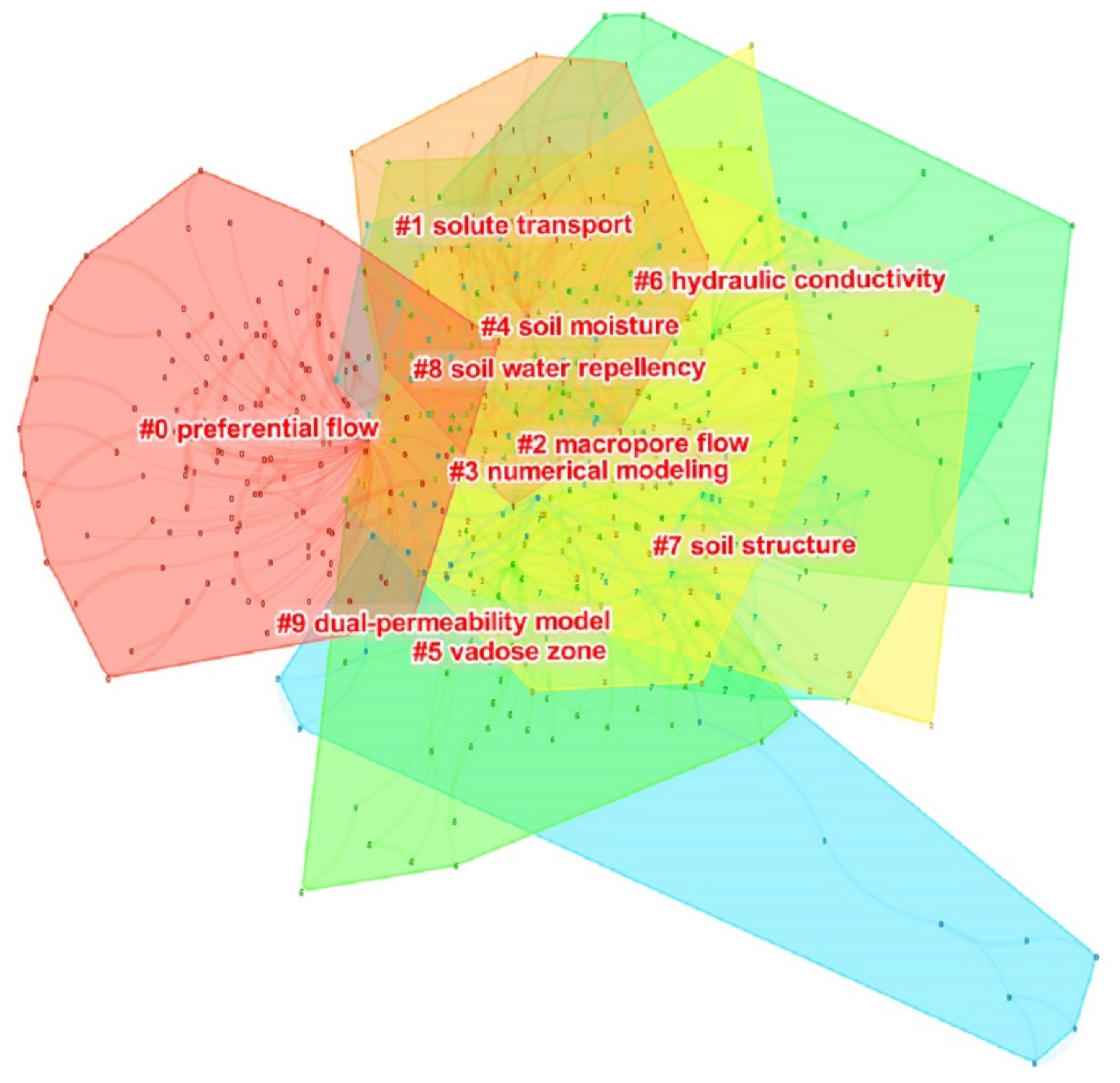
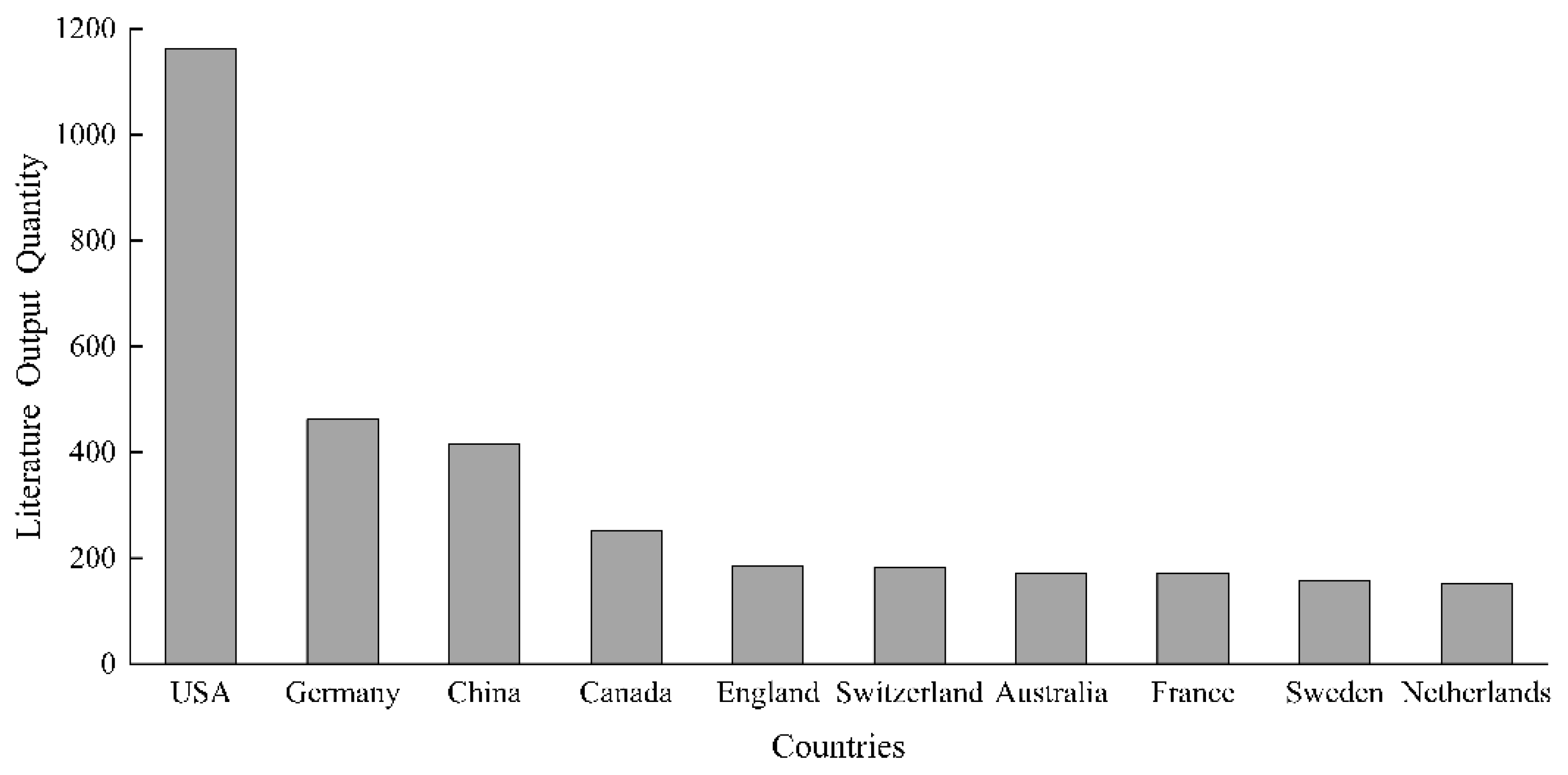
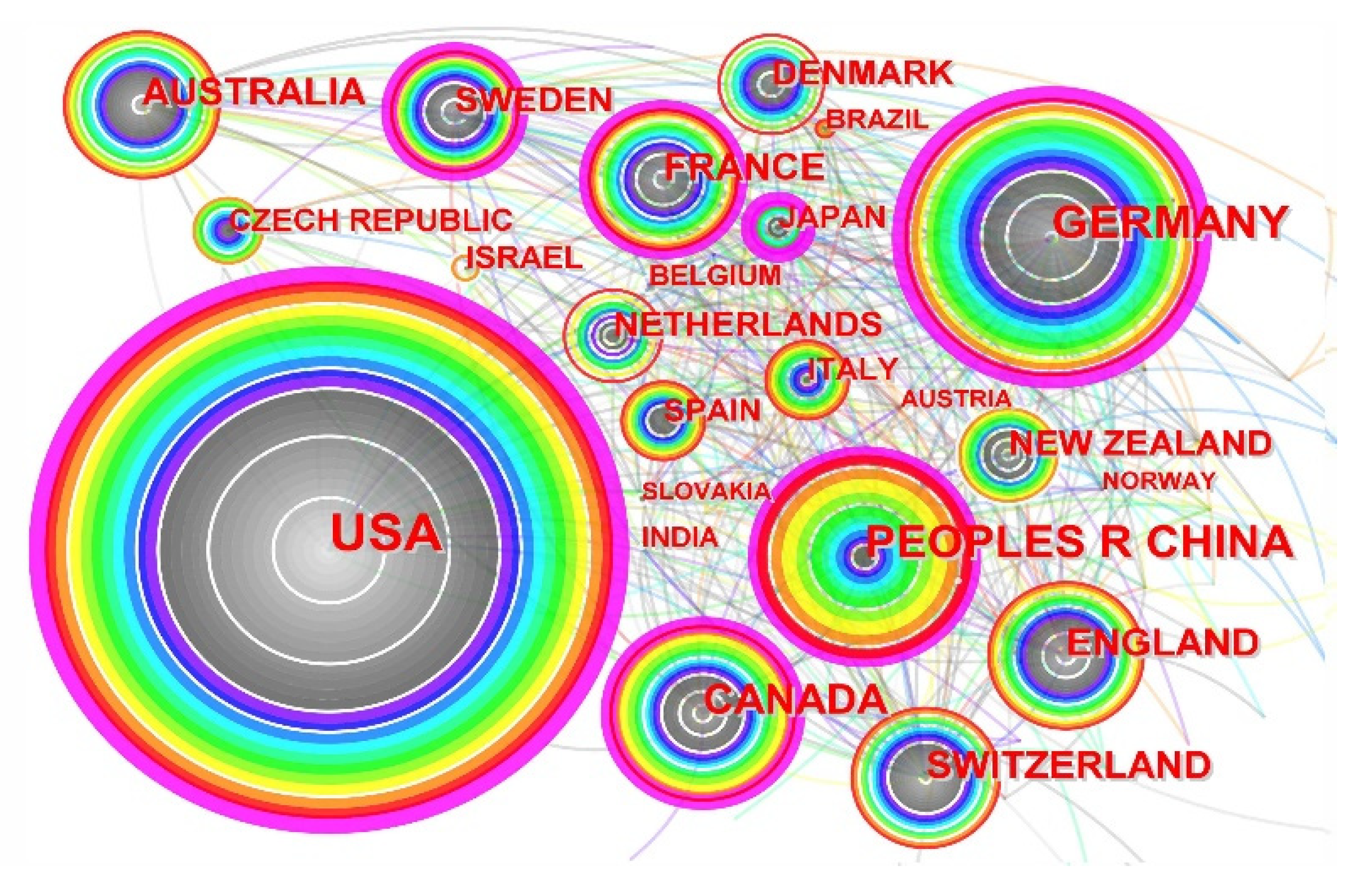
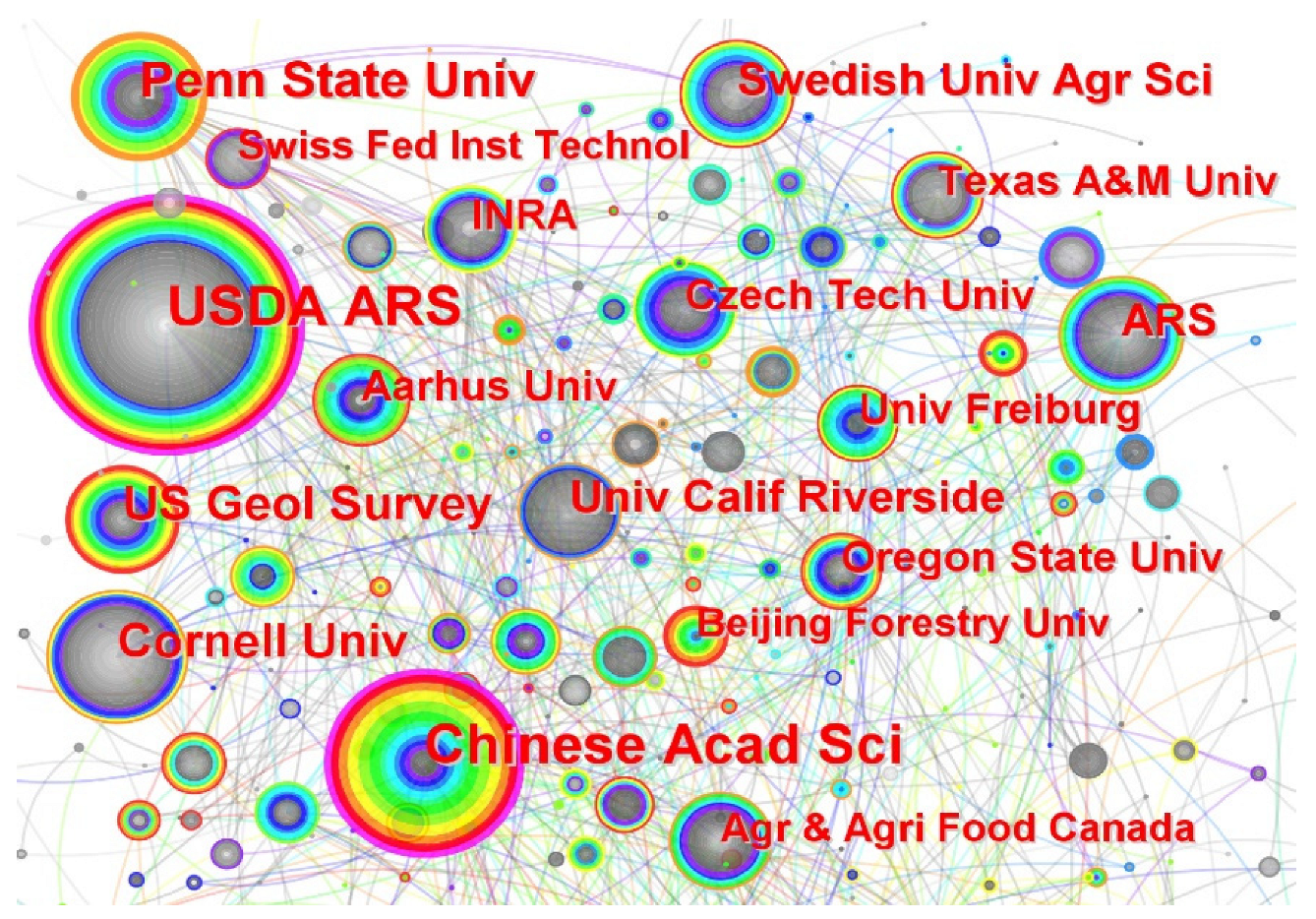
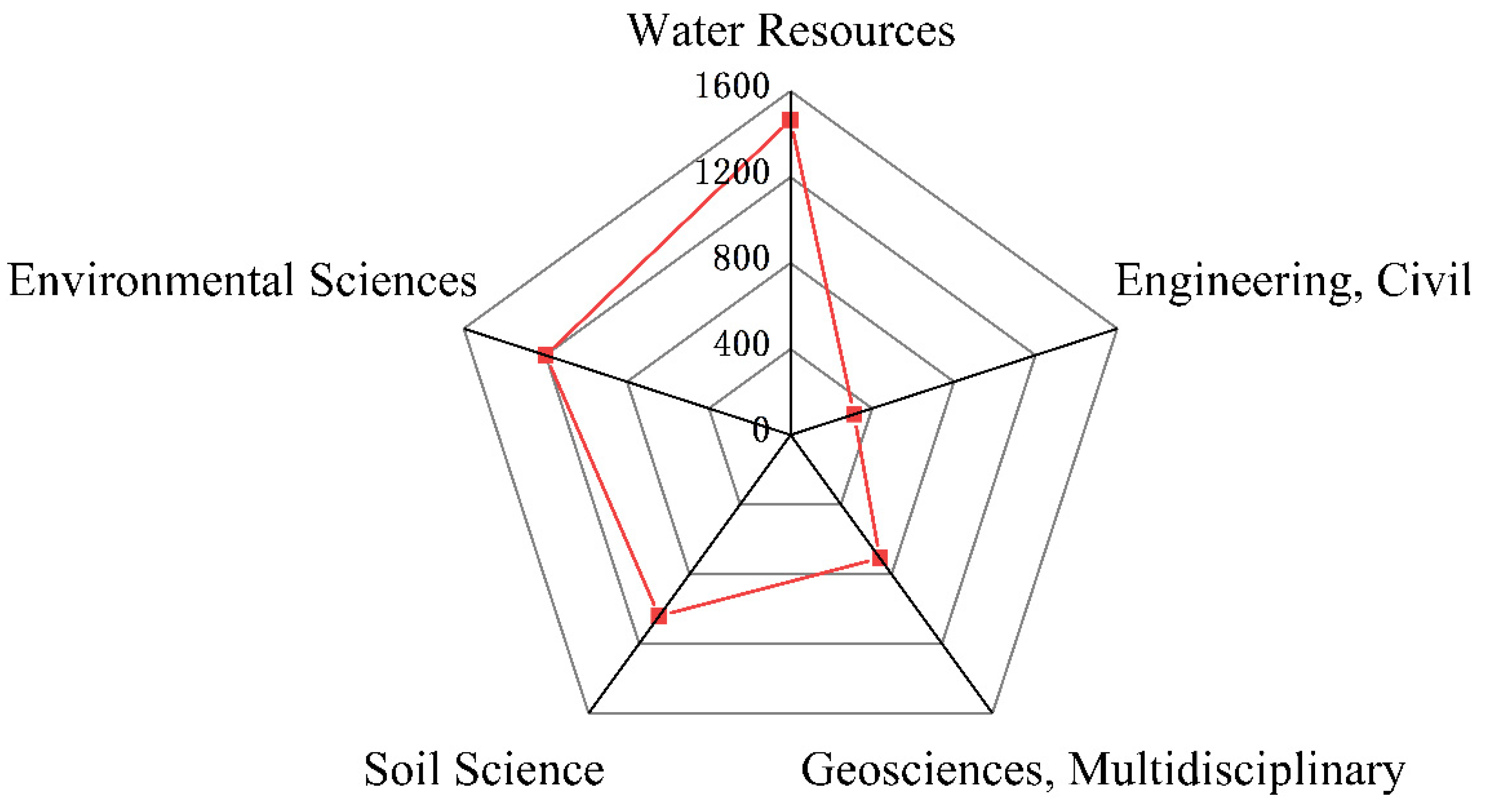

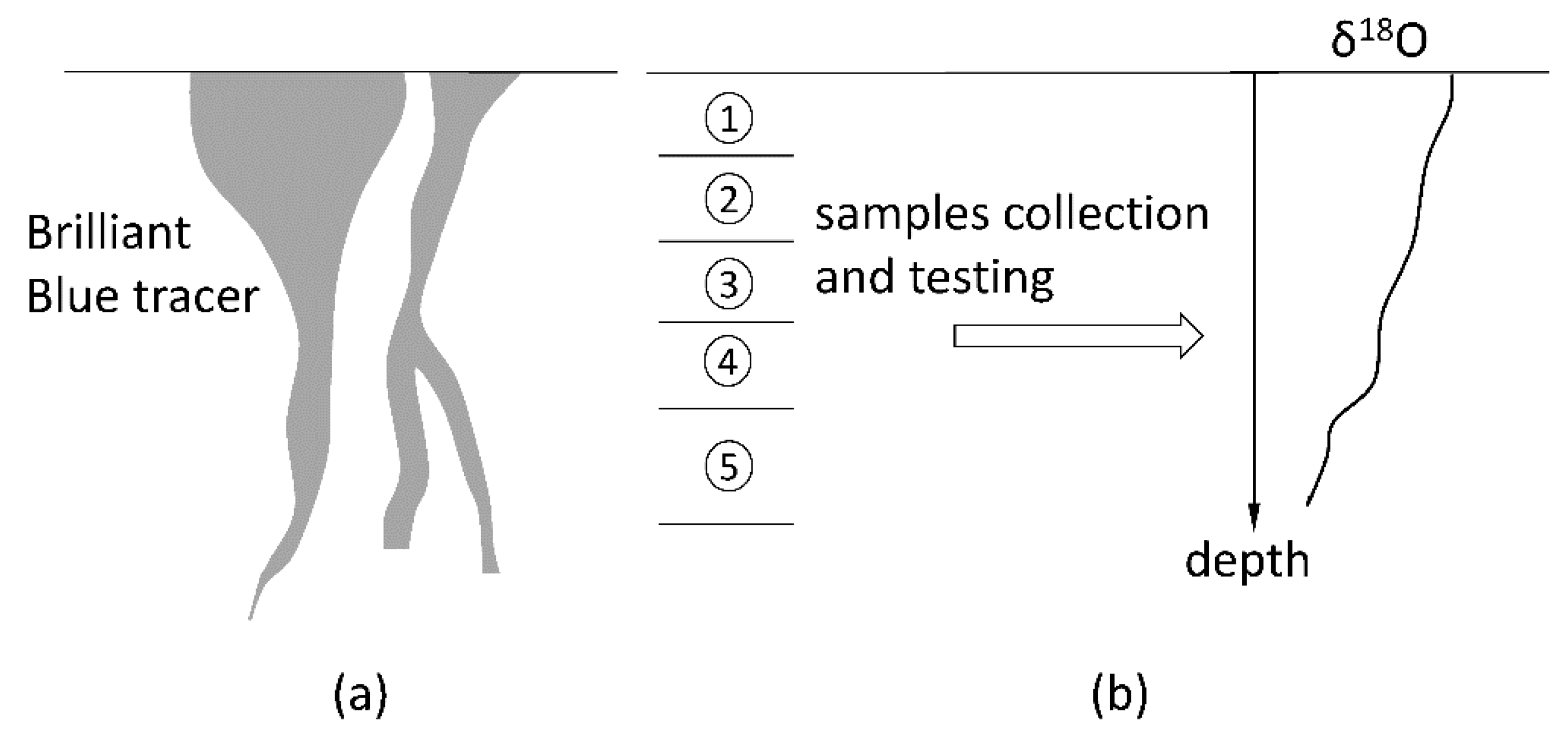
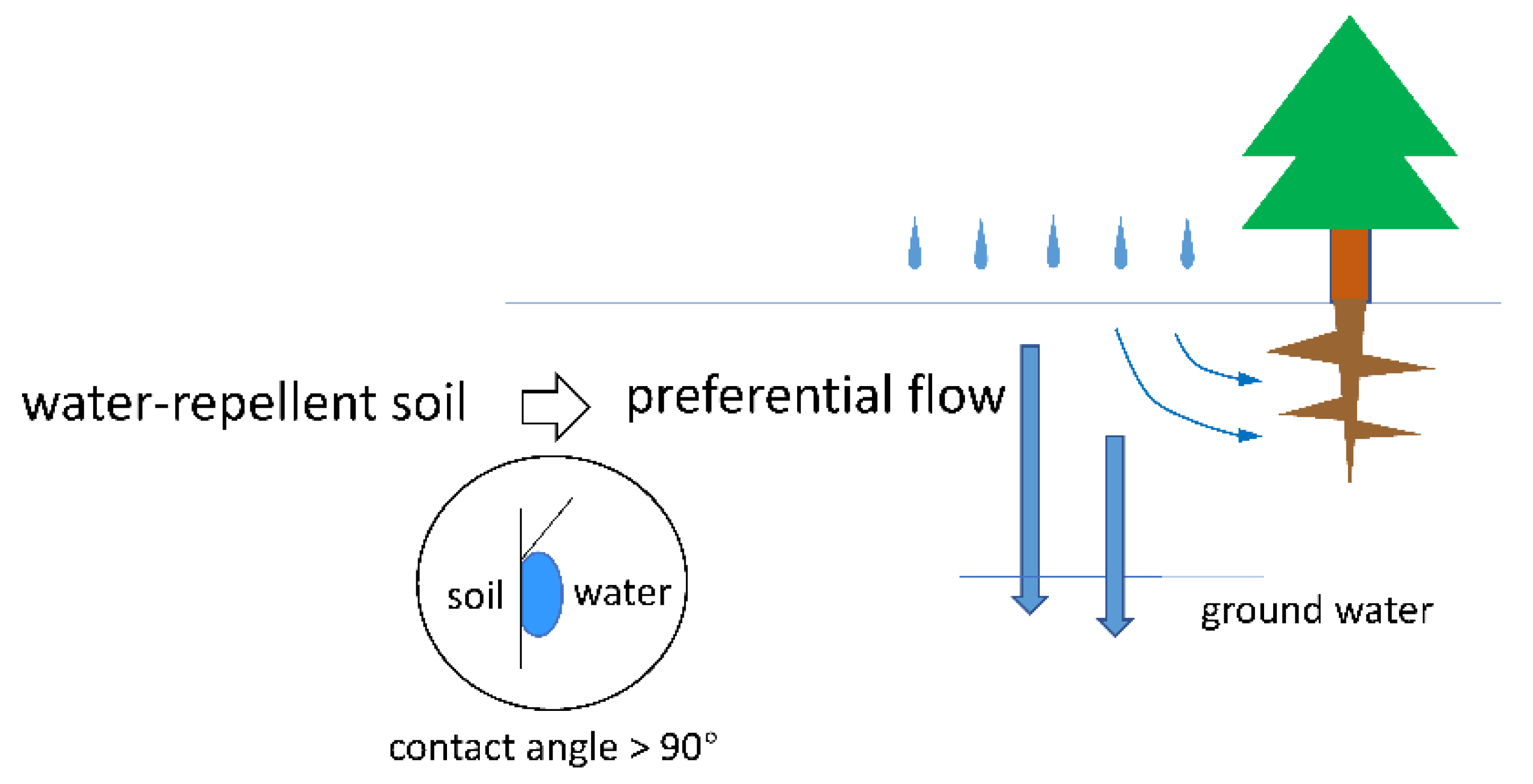

| Ranking | Keywords | Frequency |
|---|---|---|
| 1 | preferential flow | 620 |
| 2 | macropore flow | 87 |
| 3 | solute transport | 87 |
| 4 | vadose zone | 59 |
| 5 | dye tracer | 53 |
| Ranking | Keywords | Centrality |
|---|---|---|
| 1 | preferential flow | 0.73 |
| 2 | macropore flow | 0.15 |
| 3 | hydraulic conductivity | 0.11 |
| 4 | solute transport | 0.1 |
| 5 | vadose zone | 0.08 |
| Cluster ID | Clusters | Representative Keywords (LLR) |
|---|---|---|
| #0 | preferential flow | macropore flow; critical soil water content; Richards equation; hydraulic conductivity |
| #1 | solute transport | soil water; water repellency; water flow; piston flow |
| #2 | macropore flow | water balance; model; preferential flow; dye tracer experiment |
| #3 | numerical modeling | dye tracer; unsaturated zone; breakthrough curves; dye tracing |
| #4 | soil moisture | hillslope hydrology; subsurface flow; runoff generation; subsurface stormflow |
| #5 | vadose zone | unsaturated flow; contaminant transport; capillary barrier; bromide tracer |
| #6 | hydraulic conductivity | X-ray CT; bulk density; soil macropore; preferential flow |
| #7 | soil structure | bypass flow; air permeability; saturated hydraulic conductivity; cracking clay soil |
| #8 | soil water repellency | soil water content; soil matrix; soil hydrology; soil properties |
| #9 | dual-permeability model | hillslope discharge; forest soil; soil pore structure; single-porosity model |
| No. | Research Scales | Representative Keywords |
|---|---|---|
| 1 | pore scale | X-ray CT; soil macropore; soil matrix |
| 2 | field scale | dye tracer experiment; dye tracer; breakthrough curves; dye tracing |
| 3 | hillslope or catchment scale | hillslope hydrology; subsurface flow; runoff generation; subsurface stormflow; hillslope discharge |
| Burst Terms | Strength | Begin Year | End Year | 1992–2021 |
|---|---|---|---|---|
| macropore flow | 4.97 | 1997 | 1998 | ☐☐☐☐☐■■☐☐☐☐☐☐☐☐☐☐☐☐☐☐☐☐☐☐☐☐☐☐☐ |
| unsaturated flow | 3.88 | 1998 | 2004 | ☐☐☐☐☐☐■■■■■■■☐☐☐☐☐☐☐☐☐☐☐☐☐☐☐☐☐ |
| unsaturated zone | 4.00 | 2000 | 2005 | ☐☐☐☐☐☐☐☐■■■■■■☐☐☐☐☐☐☐☐☐☐☐☐☐☐☐☐ |
| water repellency | 8.31 | 2005 | 2010 | ☐☐☐☐☐☐☐☐☐☐☐☐☐■■■■■■☐☐☐☐☐☐☐☐☐☐☐ |
| pesticide leaching | 3.94 | 2005 | 2007 | ☐☐☐☐☐☐☐☐☐☐☐☐☐■■■☐☐☐☐☐☐☐☐☐☐☐☐☐☐ |
| water balance | 3.87 | 2005 | 2010 | ☐☐☐☐☐☐☐☐☐☐☐☐☐■■■■■■☐☐☐☐☐☐☐☐☐☐☐ |
| subsurface flow | 4.44 | 2010 | 2016 | ☐☐☐☐☐☐☐☐☐☐☐☐☐☐☐☐☐☐■■■■■■■☐☐☐☐☐ |
| soil moisture | 3.93 | 2011 | 2015 | ☐☐☐☐☐☐☐☐☐☐☐☐☐☐☐☐☐☐☐■■■■■☐☐☐☐☐☐ |
| dual-permeability model | 4.24 | 2012 | 2018 | ☐☐☐☐☐☐☐☐☐☐☐☐☐☐☐☐☐☐☐☐■■■■■■■☐☐☐ |
| soil water repellency | 4.35 | 2013 | 2021 | ☐☐☐☐☐☐☐☐☐☐☐☐☐☐☐☐☐☐☐☐☐■■■■■■■■■ |
| hydraulic conductivity | 3.76 | 2013 | 2017 | ☐☐☐☐☐☐☐☐☐☐☐☐☐☐☐☐☐☐☐☐☐■■■■■☐☐☐☐ |
| stable isotope | 4.84 | 2016 | 2021 | ☐☐☐☐☐☐☐☐☐☐☐☐☐☐☐☐☐☐☐☐☐☐☐☐■■■■■■ |
| runoff generation | 3.67 | 2016 | 2017 | ☐☐☐☐☐☐☐☐☐☐☐☐☐☐☐☐☐☐☐☐☐☐☐☐■■☐☐☐☐ |
| saturated hydraulic conductivity | 4.48 | 2017 | 2021 | ☐☐☐☐☐☐☐☐☐☐☐☐☐☐☐☐☐☐☐☐☐☐☐☐☐■■■■■ |
| slope stability | 3.61 | 2017 | 2021 | ☐☐☐☐☐☐☐☐☐☐☐☐☐☐☐☐☐☐☐☐☐☐☐☐☐■■■■■ |
| unsaturated soil | 3.58 | 2018 | 2021 | ☐☐☐☐☐☐☐☐☐☐☐☐☐☐☐☐☐☐☐☐☐☐☐☐☐☐■■■■ |
| No. | Research Content | Clusters and Representative Keywords |
|---|---|---|
| 1 | runoff | hydraulic conductivity; piston flow; water balance; runoff generation; unsaturated flow |
| 2 | water quality | solute transport; contaminant transport |
Publisher’s Note: MDPI stays neutral with regard to jurisdictional claims in published maps and institutional affiliations. |
© 2022 by the authors. Licensee MDPI, Basel, Switzerland. This article is an open access article distributed under the terms and conditions of the Creative Commons Attribution (CC BY) license (https://creativecommons.org/licenses/by/4.0/).
Share and Cite
Liu, C.; Yuan, Y.; Zhou, A.; Guo, L.; Zhang, H.; Liu, X. Development Trends and Research Frontiers of Preferential Flow in Soil Based on CiteSpace. Water 2022, 14, 3036. https://doi.org/10.3390/w14193036
Liu C, Yuan Y, Zhou A, Guo L, Zhang H, Liu X. Development Trends and Research Frontiers of Preferential Flow in Soil Based on CiteSpace. Water. 2022; 14(19):3036. https://doi.org/10.3390/w14193036
Chicago/Turabian StyleLiu, Chao, Ying Yuan, Aihong Zhou, Lefan Guo, Hongrui Zhang, and Xuedi Liu. 2022. "Development Trends and Research Frontiers of Preferential Flow in Soil Based on CiteSpace" Water 14, no. 19: 3036. https://doi.org/10.3390/w14193036
APA StyleLiu, C., Yuan, Y., Zhou, A., Guo, L., Zhang, H., & Liu, X. (2022). Development Trends and Research Frontiers of Preferential Flow in Soil Based on CiteSpace. Water, 14(19), 3036. https://doi.org/10.3390/w14193036






